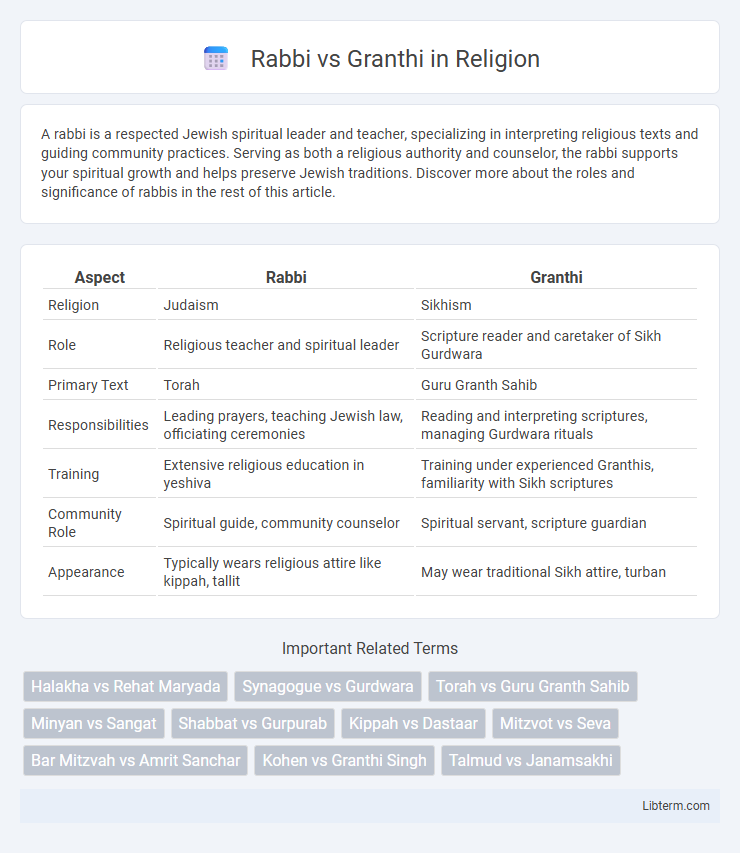A rabbi is a respected Jewish spiritual leader and teacher, specializing in interpreting religious texts and guiding community practices. Serving as both a religious authority and counselor, the rabbi supports your spiritual growth and helps preserve Jewish traditions. Discover more about the roles and significance of rabbis in the rest of this article.
Table of Comparison
| Aspect | Rabbi | Granthi |
|---|---|---|
| Religion | Judaism | Sikhism |
| Role | Religious teacher and spiritual leader | Scripture reader and caretaker of Sikh Gurdwara |
| Primary Text | Torah | Guru Granth Sahib |
| Responsibilities | Leading prayers, teaching Jewish law, officiating ceremonies | Reading and interpreting scriptures, managing Gurdwara rituals |
| Training | Extensive religious education in yeshiva | Training under experienced Granthis, familiarity with Sikh scriptures |
| Community Role | Spiritual guide, community counselor | Spiritual servant, scripture guardian |
| Appearance | Typically wears religious attire like kippah, tallit | May wear traditional Sikh attire, turban |
Understanding Spiritual Leadership: Rabbi vs Granthi
Rabbi and Granthi represent distinct spiritual leadership roles within Judaism and Sikhism, respectively, each guiding their communities through religious teachings and practices. A Rabbi serves as a Jewish religious teacher and interpreter of the Torah, providing spiritual guidance, leading synagogue services, and officiating lifecycle events, while a Granthi reads from the Guru Granth Sahib, the Sikh holy scripture, and leads congregational worship and ceremonies. Both roles emphasize scriptural knowledge and community leadership, but they differ in religious texts, rituals, and cultural contexts defining their spiritual authority.
Historical Origins of Rabbis and Granthis
Rabbis trace their historical origins to ancient Jewish religious leaders and teachers who interpreted Torah laws and guided their communities, with roles evolving since the Second Temple period. Granthis, originating within Sikhism, serve as custodians and readers of the Guru Granth Sahib, emerging during the 17th century in Punjab when Sikh scripture became central to worship. Both roles reflect distinct religious traditions: rabbis rooted in Judaic scholarship and granthis in Sikh scriptural stewardship, each developing unique community functions over centuries.
Core Religious Texts: Torah vs Guru Granth Sahib
The Rabbi serves as a religious leader in Judaism, primarily teaching and interpreting the Torah, the foundational scripture containing the Five Books of Moses and encompassing Jewish law, ethics, and history. The Granthi, in Sikhism, is responsible for reading and reciting from the Guru Granth Sahib, the central religious scripture composed of hymns and writings of Sikh Gurus and other saints, emphasizing devotion and spirituality. Both figures act as custodians of their respective sacred texts, guiding worship and preserving religious traditions within their communities.
Roles and Responsibilities in the Community
Rabbi and Granthi serve as spiritual leaders, with Rabbis primarily guiding Jewish communities through religious teachings, interpreting Torah laws, and overseeing synagogue services. Granthis focus on Sikh worship by reciting Gurbani, maintaining the Guru Granth Sahib, and performing ceremonies such as Amrit Sanchar and weddings. Both roles emphasize community leadership, education, and preserving religious traditions within their respective faiths.
Education and Training Paths
Rabbi education typically involves comprehensive religious studies in yeshivas or seminaries, emphasizing in-depth knowledge of the Torah, Talmud, and Jewish law, often culminating in ordination (semicha). Granthis undergo specialized training in Sikh theological colleges, focusing on the Guru Granth Sahib, Sikh history, and ritual practices, with a strong emphasis on Gurbani recitation and community service. While rabbis may pursue advanced academic degrees in Jewish studies, granthis primarily train in liturgical skills and the spiritual leadership required to guide congregations in Sikh Gurdwaras.
Rituals and Ceremonies Led by Rabbis and Granthis
Rabbis lead Jewish rituals such as Bar and Bat Mitzvahs, weddings, and synagogue services, guiding Torah readings and delivering sermons integral to Jewish worship. Granthis officiate Sikh ceremonies like the Anand Karaj (Sikh wedding), Akhand Path (continuous reading of the Guru Granth Sahib), and Amrit Sanskar (baptism), emphasizing hymns and recitations from the Guru Granth Sahib. Both roles are pivotal in preserving religious traditions, with Rabbis focusing on Jewish liturgy and Granthis maintaining Sikh scripture and prayers during community rituals.
Gender and Leadership Roles
Rabbi leadership roles are predominantly held by men, though many Jewish denominations actively promote female rabbis, reflecting evolving gender inclusivity. Granthis, serving as scripture readers and caretakers of the Guru Granth Sahib in Sikhism, often follow traditional male leadership, but recent shifts encourage greater participation of women. Both positions highlight dynamic intersections of gender and religious authority within their respective communities.
Places of Worship: Synagogue vs Gurdwara
Synagogues serve as the primary place of worship for Jewish communities, where Rabbis lead religious services, interpret Torah teachings, and provide spiritual guidance. Gurdwaras function as Sikh places of worship, with Granthis responsible for reading from the Guru Granth Sahib and facilitating prayers. Both Rabbis and Granthis play crucial roles in their respective faiths, fostering communal worship and religious education within Synagogues and Gurdwaras.
Attire and Symbols of Office
Rabbis typically wear a kippah or yarmulke and a tallit, with some occasions calling for a black hat or suit, symbolizing Jewish identity and religious authority. Granthis, as Sikh scripture readers, often wear a turban and traditional kurta-pajama, with the Sikh emblem Khanda occasionally displayed, representing their role in Sikh worship and scripture recitation. Both roles emphasize attire and symbols that reflect their distinct religious traditions and responsibilities within their communities.
Modern Challenges and Evolving Roles
Rabbi and Granthi roles face modern challenges such as adapting religious teachings to contemporary social issues and embracing digital platforms for community engagement. Rabbis increasingly navigate diverse congregations with varying degrees of observance, while Granthis address preservation of Sikh scripture alongside fostering youth participation in gurdwaras. Both roles evolve by integrating traditional rituals with technological advancements to maintain relevance in rapidly changing cultural landscapes.
Rabbi Infographic

 libterm.com
libterm.com